
No respite from flood threat for thousands in Que., Ont., and N.B.
OTTAWA — More Canadian soldiers are helping in the battle to sandbag homes against the still-rising floodwaters in central and eastern Canada than are deployed overseas, Defence Minister Harjit Sajjan says, though in a few places the water is slowly beginning to recede.
States of emergency have been declared in Quebec, Ontario, and New Brunswick as waters reach or surpass historic flood levels reached, in some cases, just two years ago.
Thousands of people have been forced from their homes, including 9,500 in Quebec — two-thirds of them in Ste-Marthe-sur-le-Lac, west of Montreal, after fleeing water from the Lake of Two Mountains that burst through a natural dike Saturday — and more are being urged to leave before water cuts them off from help.


